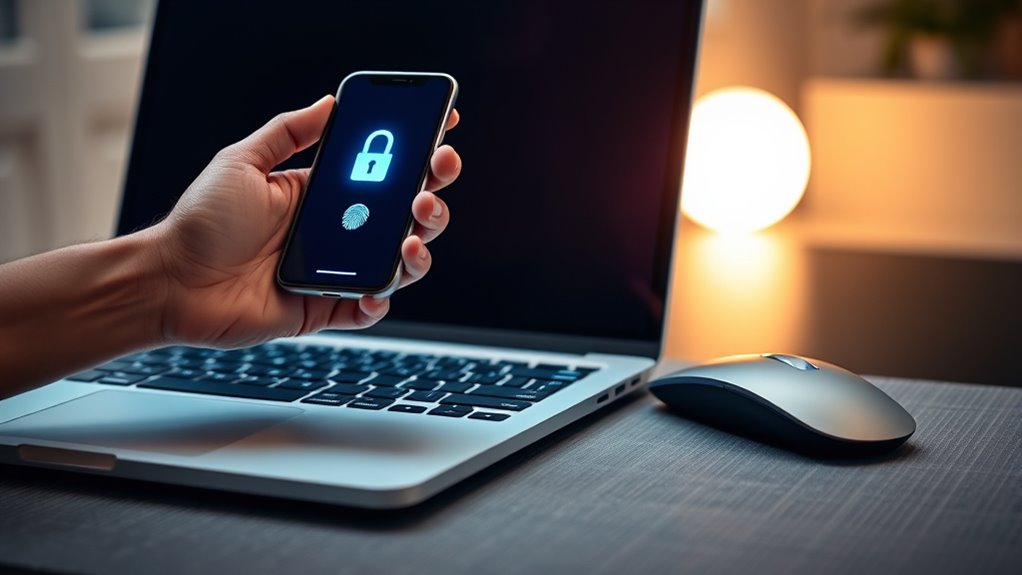To set up multi-factor authentication, first check if your device or account supports biometric verification like fingerprint or face recognition, or security tokens such as hardware devices or authenticator apps. Enable these features in your device or account settings, then register your chosen methods. Use biometrics during login or input one-time codes from tokens for added security. This process helps protect your accounts effectively; keep going to discover more tips to strengthen your online safety.
Key Takeaways
- Check if your device or account supports MFA, biometric options, or security tokens.
- Enable biometric verification in your device or application settings.
- Register a security token or authenticator app for your account.
- Follow prompts to link your biometric data or token during setup.
- Test MFA by logging in and verifying both password and second authentication factor.

To protect your online accounts from unauthorized access, setting up multi-factor authentication (MFA) is essential. MFA adds an extra layer of security by requiring you to verify your identity through multiple methods. This approach substantially reduces the risk of someone gaining unauthorized access, even if they’ve obtained your password. One effective way to do this is through biometric verification, which uses unique biological traits like fingerprints or facial recognition. When you enable biometric verification on your devices or accounts, you ensure that only you can access them, as these identifiers are difficult to replicate or steal. Many smartphones and security platforms now support biometric authentication, making it easy to incorporate into your login process.
In addition to biometric verification, a security token is another powerful element of MFA. A security token is a physical device or a digital app that generates a one-time code, which you input alongside your password. These tokens are designed to produce a unique code every few seconds, making it nearly impossible for hackers to predict or reuse. When you use a security token, even if someone manages to steal your password, they won’t be able to access your account without the token’s current code. Many services now support hardware tokens like YubiKey or RSA SecurID, which plug into your device or connect via Bluetooth. Alternatively, software-based tokens, such as authenticator apps, generate codes on your phone, providing the same level of security with added convenience.
Setting up MFA with biometric verification and security tokens is straightforward. First, check if your account or device supports these features. For biometric verification, you’ll typically need to enable fingerprint or facial recognition within your device settings or app preferences. Once activated, you’ll be prompted to authenticate using your biometric trait during login attempts. For security tokens, you’ll usually need to register the device or app with your account. This process involves linking the token to your account, after which you’ll be prompted to use it whenever logging in. Many platforms also offer backup options or alternative methods, ensuring you won’t get locked out if your primary authentication method isn’t available. Additionally, understanding the benefits of multi-factor authentication can help you appreciate the importance of these security layers.
Integrating biometric verification and security tokens into your MFA setup not only enhances your security but also makes the login process more seamless. You won’t have to remember complex passwords or carry multiple devices; instead, your unique biological features and a physical token safeguard your accounts. By taking these steps, you’re making it much harder for cybercriminals to breach your accounts, giving you peace of mind and a stronger defense against identity theft. Remember, the more layers you add, the better protected your online presence will be.
Frequently Asked Questions
Can MFA Be Bypassed by Hackers?
MFA can be bypassed by hackers, especially if there are vulnerabilities in the system. Hackers use methods like phishing, SIM swapping, or exploiting MFA vulnerabilities to bypass protections. While MFA substantially boosts security, it’s not foolproof. You should stay vigilant, keep your authentication methods updated, and use stronger options like biometric or hardware tokens to minimize the chances of hackers bypassing your multi-factor authentication.
What Are Common MFA Methods Used Today?
Your security is under attack—don’t let hackers walk right in! Today, common MFA methods include biometric authentication, like fingerprint or facial scans, which are incredibly secure, and hardware tokens, small devices generating unique codes. These methods add layers of protection, making it nearly impossible for intruders to access your accounts without your permission. Using these, you markedly boost your defenses against cyber threats.
How Often Should I Update My MFA Settings?
You should update your MFA settings regularly, ideally every 3 to 6 months, to stay ahead of security threats. Follow your organization’s security policies, which may specify more frequent updates based on risk levels. Keeping your authentication methods current minimizes vulnerabilities, especially if there’s a breach or new threats emerge. Regular updates ensure your accounts stay protected, giving you peace of mind and aligning with best cybersecurity practices.
Is MFA Necessary for Personal Accounts?
Yes, MFA is necessary for personal accounts because it adds an extra layer of security, protecting your sensitive information. To maximize its effectiveness, practice good password management and stay informed through user education about potential threats. Enabling MFA helps prevent unauthorized access, even if your password gets compromised. It’s a simple step that considerably enhances your account security, giving you peace of mind and better protection against cyber threats.
What Should I Do if I Lose Access to MFA Devices?
Losing access to your MFA devices is like losing the keys to your digital kingdom. Act quickly by using account recovery options—many services offer backup codes or alternative verification methods. Guarantee your device security remains intact during this process to prevent unauthorized access. Contact customer support if needed, and once regained, update your recovery options. This keeps your accounts protected and minimizes downtime, turning a crisis into a manageable situation.
Conclusion
Now that you’ve set up multi-factor authentication, your accounts are practically indestructible—like a fortress guarded by dragons! No hacker can slip past your defenses now. With this tiny setup, you’ve turned your security from a flimsy paper umbrella into a titanium fortress. So go ahead, sleep soundly knowing your digital life is protected better than the crown jewels. You’re officially a security superhero—cape not included!









